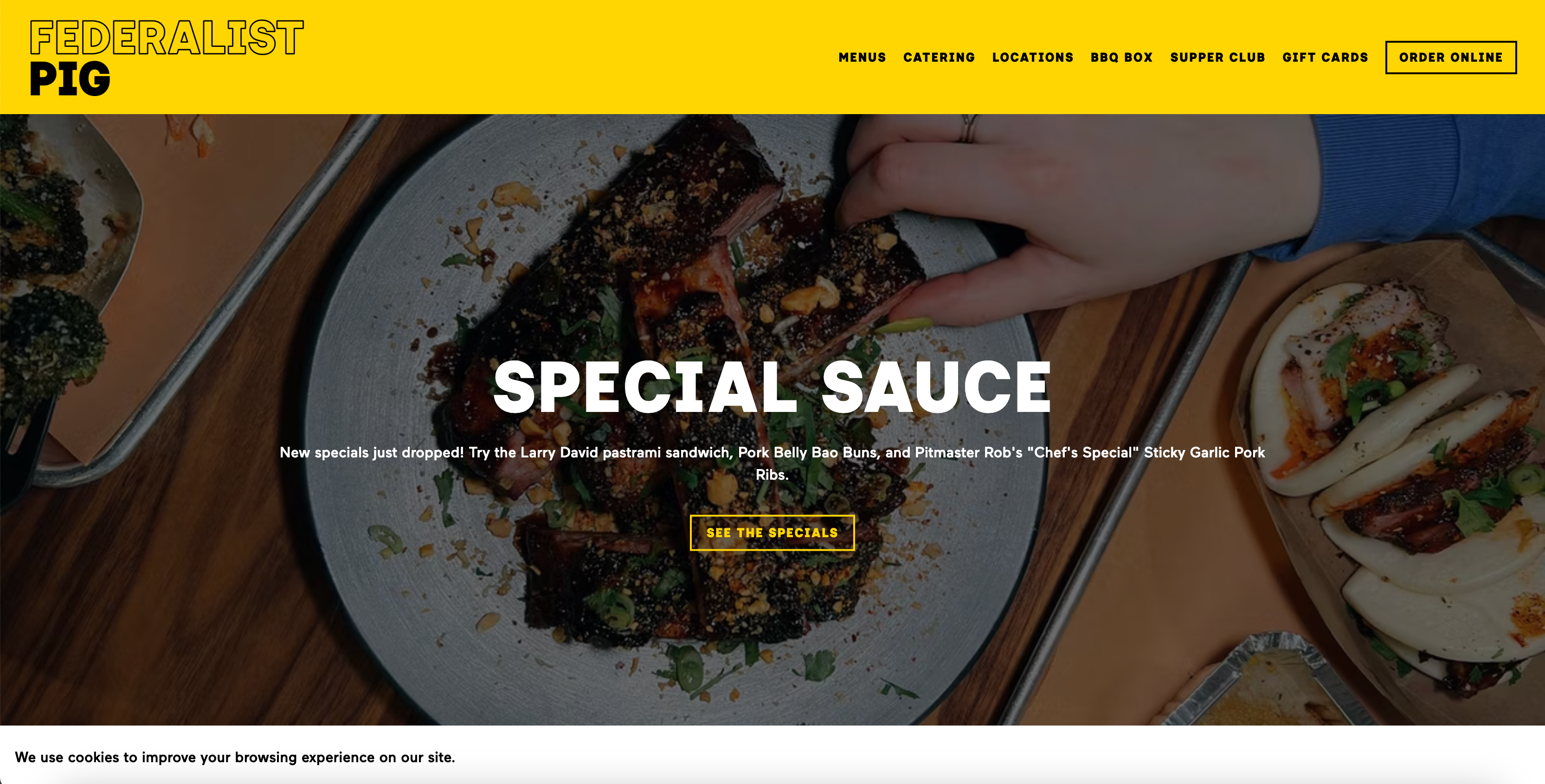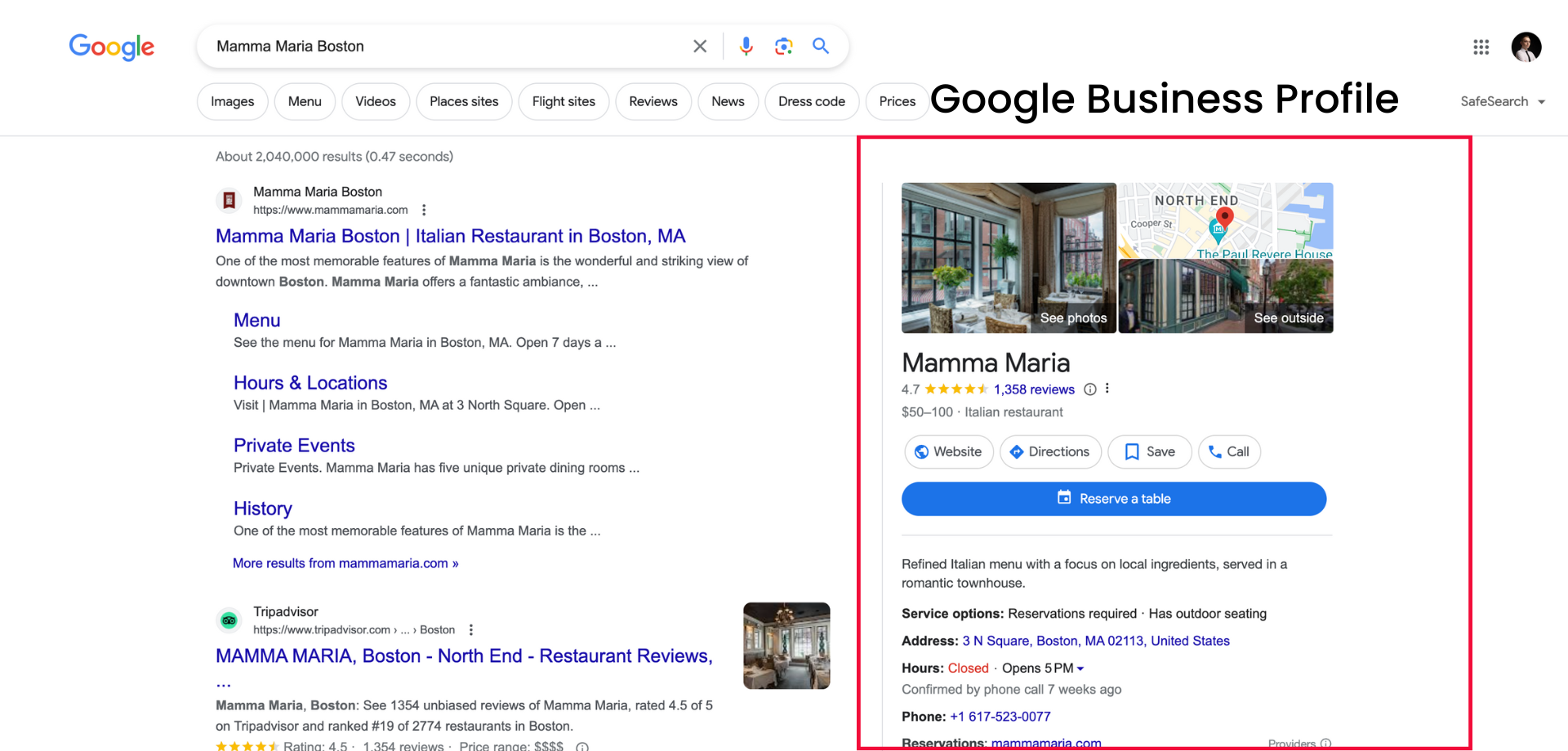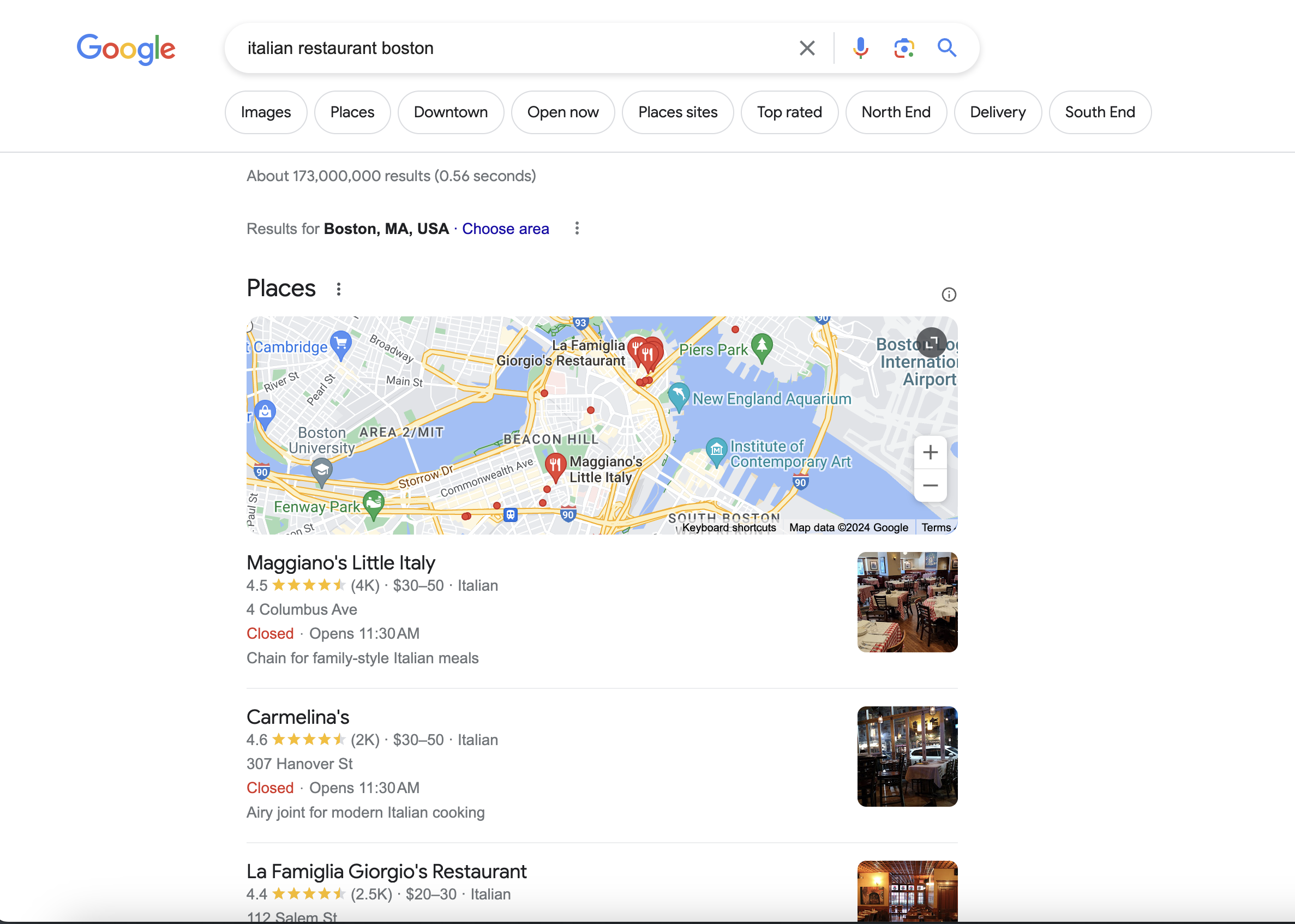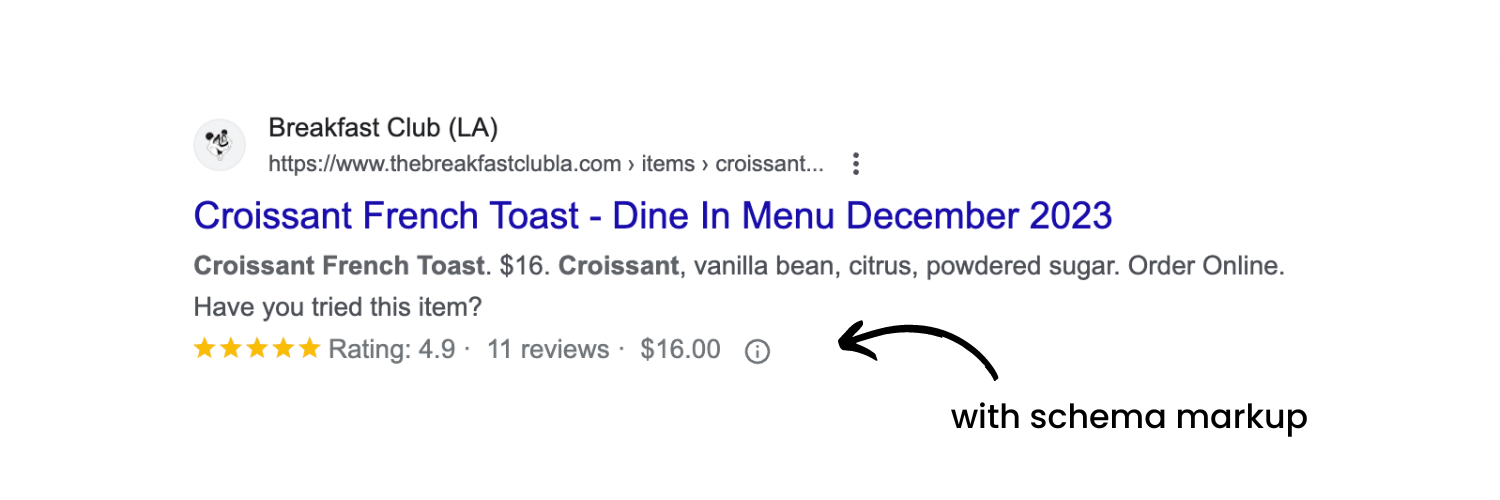Let’s face it: we’re all part of the digital era where an online presence is not just a bonus; it’s a must-have for your restaurant.
Ever wondered where people look first when their stomachs start growling? You guessed it: they’re reaching for their smartphones or jumping onto their computers to find where to eat next. That’s exactly why it’s crucial for your restaurant to show up in those searches.
People search for the perfect place to grab a bite online, whether it’s a casual lunch or a lavish dinner. Your strong online presence ensures your restaurant is right there, ready to welcome them.
It’s particularly vital now when the online ordering system has become the norm, and over half of the orders from millennials are for takeout or delivery (source). So it’s more than important to be visible in the search results whenever someone googles “pizza near me.”
What Is Search Engine Optimization (SEO)?
Search engine optimization (SEO for short) is a digital marketing strategy aimed at enhancing your restaurant’s online presence to secure a top spot in search engine results. This involves making changes to your restaurant website and creating content designed to pop up and grab attention when people look online for places to eat.
Here’s the deal: If someone in Los Angeles is dying for some pizza and types “pizza near me” into Google, you want your spot to show up right at the top, maybe even with a handy map showing where you are. Why? Because let’s be honest, most of us just look at the first page of Google and don’t bother with the second.
In essence, SEO is about ensuring that when people use Google (and other search engines) to find a great place to eat, your restaurant stands out as the top choice. By focusing on the use of relevant keywords, improving search rankings, and optimizing your restaurant’s site for search engines, you can dramatically boost your restaurant’s online visibility.
Why You Need SEO for Your Restaurant Business
But why does this matter so much for your restaurant marketing? SEO is a powerful tool. According to lead generation statistics, it drives 1000% more traffic than organic social media.
There’s a direct correlation between search rankings and your restaurant’s visibility to potential customers. Being prominently displayed in search results means people are likely to visit your website, which means an increase in foot traffic and, ultimately, diners ready to enjoy what you have to offer.
The Importance of Local SEO for Restaurants

Local SEO takes the cake when it comes to driving customers right to your doorstep. Why? Because it focuses on optimizing your online presence for a specific geographical area. So, when people search for “best Italian restaurant in Boston,” and that’s exactly what you are, you want to be the first name that pops up.
This hyper-local approach to SEO is essential for restaurants for a couple of reasons. First off, most folks looking for a place to eat are thinking about convenience and proximity. They’re not going to trek across the state for a burger unless it’s something really special. Second, local SEO helps you stand out in a crowded market by connecting you with your community, which is invaluable for building a loyal customer base.
Restaurant SEO Tips in 12 Simple Steps
Here’s a simple step-by-step guide to restaurant SEO.
1. Assessing Your Restaurant Website

For people just starting their journey with restaurant SEO, the first step should always be reviewing their restaurant websites.
The initial website audit serves as a comprehensive evaluation of your site’s current SEO health, user experience, and content relevance. It’s like taking stock of their kitchen, dining area, and menu offerings to pinpoint areas needing improvement for a better customer experience.
The audit should cover website design, navigation, mobile responsiveness, content quality, and technical SEO aspects like site speed and security.
How to do this? Use Google Analytics to assess user behavior on your site. Identify pages with high bounce rates or low engagement, indicating where improvements are needed. For instance, if your menu page has a high bounce rate, it might not be mobile-friendly or up-to-date.
Actionable Tips:
- Utilize tools like Google Analytics and Google Search Console to gather data on website performance, user engagement, and search traffic.
- Conduct a mobile usability test to ensure the website is mobile-friendly.
- Analyze page loading times with Google PageSpeed Insights and identify elements that slow down your site.
- Review your content for relevancy, freshness, and engagement. Update outdated information and enhance pages with high-quality images and engaging descriptions.
2. Keyword Research
Keyword research is about understanding the language your potential customers use when searching for dining options online.
It involves identifying not just popular relevant search terms but also niche keywords that can attract a more targeted audience. This step is crucial for tailoring your website and content to meet the search intent of your audience, thereby increasing your visibility in search results.
Use Senuto or Google’s Keyword Planner to research keywords specific to your restaurant’s offerings, such as “Mexican restaurant in [City Name]” or “best seafood in [City Name].” Look at competitors’ sites to see which keywords they’re targeting.
Actionable Tips:
- Compile a list of basic keywords related to your restaurant, including cuisine type, menu items, and location.
- Expand your keyword list by including long-tail keywords, which are more specific and less competitive.
- Use keyword research tools like Google Keyword Planner, SEMrush, or Ahrefs to analyze keyword volume and competition.
- Incorporate local keywords to capture users searching for restaurants in your area.
3. Optimize for Google Business Profile

Your Google Business Profile (GBP) acts as a digital storefront for your restaurant on Google’s services, including Google Maps and Search. A well-optimized GBP can improve your restaurant’s visibility in local searches, and help in attracting customers. It also provides essential information like hours of operation, menu, and reviews at a glance.
Claim your GBP if you haven’t already, and ensure all information is complete and accurate. Regularly update your profile with new photos, respond to reviews to show engagement, and use the posts feature to announce specials, events, or new menu items.
Actionable Tips:
- Ensure your restaurant’s name, address, and phone number (NAP) are consistent across your GBP and all online listings.
- Add high-quality photos of your restaurant, menu items, and special events.
- Encourage satisfied customers to leave positive reviews and respond professionally to all reviews.
- Utilize the GBP posts feature to keep your customers informed about what’s new.
4. Local SEO

Optimizing your online presence for local customers. You want to appear in local search results whenever someone is looking for restaurants in your vicinity. This involves not just optimizing your website and GBP but also managing local citations (listings) and leveraging local content and backlinks to boost your local search visibility.
Actionable Tips:
- Claim and optimize your listings on local directories and review sites, like Yelp, TripAdvisor, and local food blogs.
- Make sure your NAP information is consistent across these listings.
- Create locally relevant content that resonates with your community.
- Engage in local community events and sponsorships, and share these activities on your website and social media.
5. Mobile-Friendliness
With the increasing prevalence of smartphone use, a mobile-friendly website is essential for providing a positive user experience. Nowadays, 63% of Google searches originate from smartphones and tablets (source).
Mobile-friendliness affects not only user engagement but also search engine rankings, as search engines favor websites that are optimized for mobile devices.
Test your website’s mobile responsiveness using Google’s Mobile-Friendly Test tool. Look for issues like text that’s too small to read, buttons that are too close together, and images that don’t scale properly on smaller screens.
Actionable Tips:
- Use a responsive website design that automatically adjusts to fit the screen size of the device it’s being viewed on.
- Simplify menus and navigation for ease of use on mobile devices.
- Optimize images and videos to load quickly on mobile networks.
- Ensure clickable elements are spaced adequately for touch navigation.
6. Improve Website Performance
Website performance, including page load time, directly impacts user experience and SEO. Faster websites provide a better user experience, reduce bounce rates, and are favored by search engines. Improving your website’s performance involves optimizing images, leveraging browser caching, and minimizing code.
Analyze your website’s speed using tools like GTmetrix or Google PageSpeed Insights. Identify specific issues, such as large images or excessive JavaScript, and address these issues to improve load times.
Actionable Tips:
- Compress images before uploading them to your website to reduce file size without losing quality.
- Minimize the use of heavy plugins and widgets that can slow down your site.
- Use caching to reduce load times for repeat visitors.
- Minify CSS, JavaScript, and HTML to reduce file sizes and improve speed.
7. On-page SEO
On-page SEO involves optimizing individual web pages to rank higher and earn more relevant traffic in search engines. This includes optimizing content, title tags, meta descriptions, and headers to include targeted keywords and improve user engagement.
Review your menu page to ensure it includes descriptive, keyword-rich titles and descriptions. For example, instead of an online menu simply listing “Salad,” describe it as “Fresh Organic Garden Salad with Homemade Dressing.” Make sure your menus are text-based instead of an image or PDF, this will also help your restaurant SEO.
Actionable Tips:
- Use title tags and meta descriptions that accurately describe the content of each page and include relevant keywords.
- Structure content with headers (H1, H2, etc.) to make it easier for users to read and for search engines to understand.
- Optimize images with descriptive alt tags that include relevant keywords.
- Ensure internal links use descriptive anchor text and link to relevant pages on your site.
8. Schema Markup

Schema markup is like a secret code for your website that helps search engines understand your content better. For restaurants, this means making sure things like your menu, opening hours, location, and special deals are clear to search engines like Google.
By using schema markup, you’re helping your restaurant’s info show up directly in search results, not just as a link but with extra details like ratings, prices, and what kind of food you serve. It’s a great way to catch someone’s eye when they’re searching for a place to eat.
Actionable Tips:
- Use online tools to generate schema markup for your restaurant. Include details like your menu items, prices, location, and hours.
- If your restaurant has special offers or unique features, make sure these are included in your schema markup. This can make your listing more attractive in search results.
- Keep your schema markup updated with the latest info about your restaurant. This ensures that searchers always see accurate and helpful information.
Using schema markup can really make your restaurant stand out in search results, helping attract more customers by showcasing what makes your place special right from the get-go.
9. Optimize Existing Content
Updating and optimizing existing content ensures it remains relevant and can continue to attract traffic. This might involve refreshing outdated information, adding new keywords, and improving readability. Revise older blog posts about your menu to include new dishes or updated pricing, ensuring all content reflects your current offerings and incorporates targeted keywords.
Actionable Tips:
- Review and update your most visited pages and posts.
- Incorporate new keyword research into existing content.
- Improve the structure of your content for better readability and engagement.
10. Create New Content
Keeping your website loaded with fresh, engaging content is key to pulling in more visitors and boosting your SEO game. Think about adding new blog posts, exciting videos, or fresh pages to your site.
Consider kicking off a blog right on your restaurant’s website. It’s a great spot to dish out delicious recipes, share behind-the-scenes stories from the kitchen, or hype up your next big event. Make sure to sprinkle in those keywords and topics that your crowd loves.
Don’t forget the power of online reviews. Showcasing what others say about your dining experience can work wonders.
Actionable Tips:
- Zero in on what your visitors are curious about.
- Keep the content coming regularly, making sure it’s both top-notch and rich in keywords.
- Use a blend of texts, pictures, and videos to catch the eye of different types of content consumers.
11. Backlinks
Links to your website from other reputable sites are very important for restaurant SEO. These backlinks signal to search engines that your content is valuable and authoritative, improving your site’s SEO.
Partner with local food bloggers or media outlets for reviews or features on your restaurant, resulting in high-quality links for your site.
Actionable Tips:
- Engage in guest blogging on reputable sites in your industry or local area.
- Partner with local businesses and organizations for cross-promotion.
- Create shareable content that naturally attracts backlinks, such as unique recipes or insights into the local dining scene.
12. Monitor Performance
Continuously monitoring your restaurant SEO performance allows you to understand what’s working, identify areas for improvement, and adjust your strategy accordingly. Use Google Analytics to track website traffic, conversion rates, and other key performance indicators (KPIs), and Google Search Console to monitor your search rankings and visibility.
Actionable Tips:
- Regularly review your site’s performance in Google Analytics and Google Search Console.
- Set up goals in Google Analytics to track conversions from your SEO efforts.
- Adjust your SEO strategy based on performance data to continuously improve your results.
Bonus Tip: Make Sure You’re Listed in Popular Online Directories
Let’s not forget the importance of being listed in popular online directories. It’s like the cherry on top of your SEO sundae. Being present in directories like Yelp, OpenTable, and Zomato not only increases your visibility but also lends an air of credibility and trustworthiness to your restaurant. It’s a simple step, but it’s one that can significantly impact your online presence.
SEO Tools for Restaurant Owners
- Google Analytics and Google Search Console: These tools are crucial for monitoring how website visitors find and interact with your restaurant online. They provide essential insights into your website’s performance and its standings in Google search results, helping you fine-tune your online strategy.
- Senuto: With its user-friendly interface, Senuto makes keyword analysis and visibility tracking a breeze. It helps ensure that your restaurant doesn’t just blend in with the crowd but stands out, shining brightly in search rankings. Plus, it’s more budget-friendly than big names like Ahrefs and SEMrush, making it a fantastic choice for those dipping their toes into restaurant SEO for the first time.
- SEMrush: SEMrush is your all-in-one SEO powerhouse, perfect for digging deep into keyword research, keeping an eye on the competition, and giving your site a complete health check. That said, it might take a bit to get the hang of all its features, and it does come with a price tag that’s a bit steeper than Senuto’s.
- Ahrefs: The heavyweight champion of keyword research, site audits, and backlink analysis. It’s your secret ingredient for building an unbeatable backlink profile, laying a solid SEO foundation that helps your restaurant climb to the top of Google’s search results. As for the downsides, it’s also the most expensive option for an SEO tool.
- Moz Local: An absolute must for local lead generation & restaurant SEO, Moz Local ensures your business is accurately listed across the web. This boosts your visibility in local searches, making it easier for potential diners to find you.
- Yoast SEO (for WordPress sites): If your restaurant’s website is on WordPress, Yoast SEO is your go-to plugin for on-page SEO. It guides you in optimizing content, titles, and meta descriptions, enhancing your site’s search performance and drawing in more website visitors.
- BuzzSumo: Discover what’s trending in the restaurant industry with BuzzSumo. This tool helps you understand what engages your audience, enabling you to craft content that resonates and captures the attention of potential customers.
- GTmetrix: Keep website visitors happy with a fast-loading site, thanks to GTmetrix. This tool analyzes your website’s speed and performance, offering actionable recommendations to improve user experience and keep diners coming back.
Start Working on Restaurant SEO Today!
And there you have it, a comprehensive guide to doubling your restaurant bookings through the power of SEO. Remember, SEO isn’t just about tweaking your website behind the scenes; it’s about creating an experience that resonates with your potential customers, both online and offline.
So, roll up your sleeves and dive into the world of SEO. It may seem daunting at first, but with these actionable tips, you’re well on your way to boosting your bookings and making your restaurant the talk of the town. Remember, the goal is not just to reach the top of the search results page but to create an online presence that truly reflects your restaurant’s unique flavors and experiences.
Happy optimizing!
 Ksawery Cepeniuk
Ksawery Cepeniuk